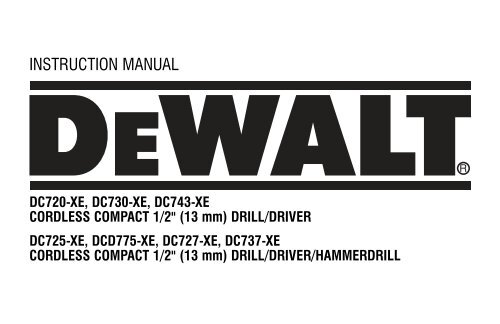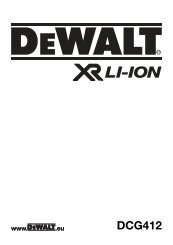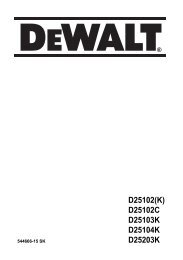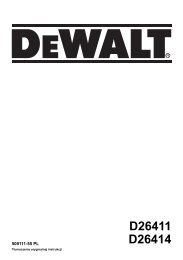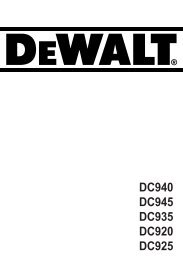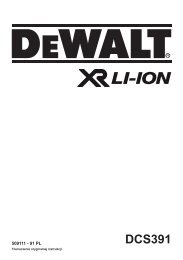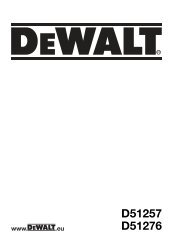Australia - New Zealand - Service - DeWALT
Australia - New Zealand - Service - DeWALT
Australia - New Zealand - Service - DeWALT
Create successful ePaper yourself
Turn your PDF publications into a flip-book with our unique Google optimized e-Paper software.
INSTRUCTION MANUAL<br />
DC720-XE, DC730-XE, DC743-XE<br />
CORDLESS COMPACT 1/2" (13 mm) DRILL/DRIVER<br />
DC725-XE, DCD775-XE, DC727-XE, DC737-XE<br />
CORDLESS COMPACT 1/2" (13 mm) DRILL/DRIVER/HAMMERDRILL
Definitions: Safety Guidelines<br />
The definitions below describe the level of severity for each signal<br />
word. Please read the manual and pay attention to these symbols.<br />
DANGER: Indicates an imminently hazardous situation which, if<br />
not avoided, will result in death or serious injury.<br />
WARNING: Indicates a potentially hazardous situation which, if<br />
not avoided, could result in death or serious injury.<br />
CAUTION: Indicates a potentially hazardous situation which, if<br />
not avoided, may result in minor or moderate injury.<br />
NOTICE: Used without the safety alert symbol indicates a<br />
potentially hazardous situation which, if not avoided, may result in<br />
property damage.<br />
IF YOU HAVE ANY QUESTIONS OR COMMENTS ABOUT THIS OR ANY DEWALT TOOL,<br />
CALL US AT: 1800 654 155 (Aust) or 0800 339258 (NZ).<br />
SAFETY INSTRUCTIONS FOR POWER TOOLS<br />
When using power tools, always observe the safety regulations applicable in your<br />
country to reduce the risk of fire, electric shock and personal injury. Read the following<br />
safety instructions before attempting to operate this product. Keep these instructions in<br />
a safe place.<br />
WARNING: To reduce the risk of injury, read the instruction manual.<br />
GENERAL POWER TOOL SAFETY WARNINGS<br />
WARNING! Read all safety warnings and all instructions Failure to follow the<br />
warnings and instructions may result in electric shock, fire and/or serious<br />
injury.<br />
SAVE THESE INSTRUCTIONS<br />
The term “power tool” in the warnings refers to your mains-operated (corded) power<br />
tool or battery-operated (cordless) power tool.<br />
1<br />
1) WORK AREA SAFETY<br />
a) Keep work area clean and well lit. Cluttered or dark areas invite accidents.<br />
b) Do not operate power tools in explosive atmospheres, such as in the<br />
presence of flammable liquids, gases or dust. Power tools create sparks<br />
which may ignite the dust or fumes.<br />
c) Keep children and bystanders away while operating a power tool.<br />
Distractions can cause you to lose control.<br />
2) ELECTRICAL SAFETY<br />
a) Power tool plugs must match the outlet. Never modify the plug in any<br />
way. Do not use any adapter plugs with earthed (grounded) power tools.<br />
Unmodified plugs and matching outlets will reduce risk of electric shock.<br />
b) Avoid body contact with earthed or grounded surfaces such as pipes,<br />
radiators, ranges and refrigerators. There is an increased risk of electric<br />
shock if your body is earthed or grounded.<br />
c) Do not expose power tools to rain or wet conditions. Water entering a power<br />
tool will increase the risk of electric shock.<br />
d) Do not abuse the cord. Never use the cord for carrying, pulling or<br />
unplugging the power tool. Keep cord away from heat, oil, sharp edges<br />
or moving parts. Damaged or entangled cords increase the risk of electric<br />
shock.<br />
e) When operating a power tool outdoors, use an extension cord suitable<br />
for outdoor use. Use of a cord suitable for outdoor use reduces the risk of<br />
electric shock.<br />
f) If operating a power tool in a damp location is unavoidable, use a residual<br />
current device (RCD) protected supply. Use of an RCD reduces the risk of<br />
electric shock.<br />
3) PERSONAL SAFETY<br />
a) Stay alert, watch what you are doing and use common sense when<br />
operating a power tool. Do not use a power tool while you are tired or<br />
under the influence of drugs, alcohol or medication. A moment of inattention<br />
while operating power tools may result in serious personal injury.<br />
b) Use personal protective equipment. Always wear eye protection. Protective<br />
equipment such as dust mask, non-skid safety shoes, hard hat, or hearing<br />
protection used for appropriate conditions will reduce personal injuries.
c) Prevent unintentional starting. Ensure the switch is in the off position<br />
before connecting to power source and/or battery pack, picking up or<br />
carrying the tool. Carrying power tools with your finger on the switch or<br />
energising power tools that have the switch on invites accidents.<br />
d) Remove any adjusting key or wrench before turning the power tool on. A<br />
wrench or a key left attached to a rotating part of the power tool may result in<br />
personal injury.<br />
e) Do not overreach. Keep proper footing and balance at all times. This<br />
enables better control of the power tool in unexpected situations.<br />
f) Dress properly. Do not wear loose clothing or jewellery. Keep your hair,<br />
clothing and gloves away from moving parts. Loose clothes, jewellery or<br />
long hair can be caught in moving parts.<br />
g) If devices are provided for the connection of dust extraction and collection<br />
facilities, ensure these are connected and properly used. Use of dust<br />
collection can reduce dust-related hazards.<br />
4) POWER TOOL USE AND CARE<br />
a) Do not force the power tool. Use the correct power tool for your<br />
application. The correct power tool will do the job better and safer at the rate<br />
for which it was designed.<br />
b) Do not use the power tool if the switch does not turn it on and off. Any<br />
power tool that cannot be controlled with the switch is dangerous and must<br />
be repaired.<br />
c) Disconnect the plug from the power source and/or the battery pack from<br />
the power tool before making any adjustments, changing accessories,<br />
or storing power tools. Such preventive safety measures reduce the risk of<br />
starting the power tool accidentally.<br />
d) Store idle power tools out of the reach of children and do not allow<br />
persons unfamiliar with the power tool or these instructions to operate the<br />
power tool. Power tools are dangerous in the hands of untrained users.<br />
e) Maintain power tools. Check for misalignment or binding of moving parts,<br />
breakage of parts and any other condition that may affect the power tool’s<br />
operation. If damaged, have the power tool repaired before use. Many<br />
accidents are caused by poorly maintained power tools.<br />
2<br />
f) Keep cutting tools sharp and clean. Properly maintained cutting tools with<br />
sharp cutting edges are less likely to bind and are easier to control.<br />
g) Use the power tool, accessories and tool bits etc., in accordance with<br />
these instructions taking into account the working conditions and the work<br />
to be performed. Use of the power tool for operations different from those<br />
intended could result in a hazardous situation.<br />
5) BATTERY TOOL USE AND CARE<br />
a) Recharge only with the charger specified by the manufacturer. A charger<br />
that is suitable for one type of battery pack may create a risk of fire when<br />
used with another battery pack.<br />
b) Use power tools only with specifically designated battery packs. Use of any<br />
other battery packs may create a risk of injury and fire.<br />
c) When battery pack is not in use, keep it away from other metal objects like<br />
paper clips, coins, keys, nails, screws, or other small metal objects that<br />
can make a connection from one terminal to another. Shorting the battery<br />
terminals together may cause burns or a fire.<br />
d) Under abusive conditions, liquid may be ejected from the battery, avoid<br />
contact. If contact accidentally occurs, flush with water. If liquid contacts<br />
eyes, additionally seek medical help. Liquid ejected from the battery may<br />
cause irritation or burns.<br />
6) SERVICE<br />
a) Have your power tool serviced by a qualified repair person using only<br />
identical replacement parts. This will ensure that the safety of the power tool<br />
is maintained.<br />
Electrical Safety<br />
The electric motor has been designed for one voltage only. Always check that the<br />
power supply corresponds to the voltage on the rating plate. 240 V AC means your<br />
tool will operate on alternating current. As little as 10% lower voltage can cause loss<br />
of power and can result in overheating. All DEWALT tools are factory tested; if this<br />
tool does not operate, check the power supply. Your DEWALT tool is double insulated,<br />
therefore no earth wire is required.<br />
• Young children and the infirm. This appliance is not intended for use by<br />
young children or infirm persons without supervision. Young children should be<br />
supervised to ensure that they do not play with this appliance.
• Replacement of the supply cord. If the supply cord is damaged, it must be<br />
replaced by the manufacturer or an authorised DEWALT <strong>Service</strong> Centre in order<br />
to avoid a hazard.<br />
Extension Cords<br />
CAUTION: Use only extension cords that are approved by the country’s Electrical<br />
Authority. Before using extension cords, inspect them for loose or exposed wires,<br />
damaged insulation and defective fittings. Replace the cord if necessary.<br />
MINIMUM GAUGE FOR CORD SETS<br />
For Cable length (m): 7.5 15 25 30 45 60<br />
Use Cable with minimum rating (Amperes)<br />
Tool Amperes<br />
0 - 3.4 7.5 7.5 7.5 7.5 7.5 7.5<br />
3.5 - 5.0 7.5 7.5 7.5 7.5 10 15<br />
5.1 - 7.0 10 10 10 10 15 15<br />
7.1 - 12.0 15 15 15 15 20 20<br />
12.1 - 20.0 20 20 20 20 25 –<br />
Drill/Driver/Hammerdrill Safety Warnings<br />
• Wear ear protectors with impact drills. Exposure to noise can cause hearing<br />
loss.<br />
• Hold power tools by insulated gripping surfaces when performing an<br />
operation where the cutting tool may contact hidden wiring or its own cord.<br />
Contact with a “live” wire will make exposed metal parts of the tool “live” and<br />
shock the operator.<br />
• Use clamps or other practical way to secure and support the workpiece to a<br />
stable platform. Holding the work by hand or against your body is unstable and<br />
may lead to loss of control.<br />
• Wear ear protectors when hammering for extended periods of time. Prolonged<br />
exposure to high intensity noise can cause hearing loss. Temporary hearing loss<br />
or serious ear drum damage may result from high sound levels generated by<br />
hammerdrilling.<br />
• Wear safety goggles or other eye protection. Hammering and drilling operations<br />
cause chips to fly. Flying particles can cause permanent eye damage.<br />
3<br />
• Hammer bits and tools get hot during operation. Wear gloves when touching<br />
them.<br />
• Air vents often cover moving parts and should be avoided. Loose clothes,<br />
jewellery or long hair can be caught in moving parts.<br />
WARNING: ALWAYS use safety glasses. Everyday eyeglasses are NOT safety<br />
glasses. Also use face or dust mask if<br />
cutting operation is dusty. ALWAYS WEAR CERTIFIED SAFETY EQUIPMENT:<br />
• ANSI Z87.1 eye protection (CAN/CSA Z94.3),<br />
• ANSI S12.6 (S3.19) hearing protection,<br />
• NIOSH/OSHA/MSHA respiratory protection.<br />
WARNING: Some dust created by power sanding, sawing, grinding, drilling, and<br />
other construction activities contains chemicals known to cause cancer, birth defects<br />
or other reproductive harm. Some examples of these chemicals are:<br />
• lead from lead-based paints,<br />
• crystalline silica from bricks and cement and other masonry products, and<br />
• arsenic and chromium from chemically-treated lumber (CCA).<br />
Your risk from these exposures varies, depending on how often you do this type of<br />
work. To reduce your exposure to these chemicals: work in a well ventilated area, and<br />
work with approved safety equipment, such as those dust masks that are specially<br />
designed to filter out microscopic particles.<br />
• Avoid prolonged contact with dust from power sanding, sawing, grinding,<br />
drilling, and other construction activities. Wear protective clothing and wash<br />
exposed areas with soap and water. Allowing dust to get into your mouth, eyes,<br />
or lay on the skin may promote absorption of harmful chemicals.<br />
WARNING: Use of this tool can generate and/or disburse dust, which may cause<br />
serious and permanent respiratory or other injury. Always use NIOSH/OSHA approved<br />
respiratory protection appropriate for the dust exposure. Direct particles away from<br />
face and body.<br />
WARNING: ALWAYS wear proper personal hearing protection that conforms to<br />
ANSI S12.6 (S3.19) during use. Under some conditions and duration of use, noise<br />
from this product may contribute to hearing loss.<br />
CAUTION: When not in use, place tool on its side on a stable surface where it<br />
will not cause a tripping or falling hazard. Some tools with large battery packs will<br />
stand upright on the battery pack but may be easily knocked over.
• The label on your tool may include the following symbols. The symbols and their<br />
definitions are as follows:<br />
V ................. volts A ...............amperes<br />
Hz ............... hertz W ..............watts<br />
min ............. minutes ...........alternating current<br />
.......... direct current ...........alternating or direct current<br />
.............. Class I Construction no ..............no load speed<br />
................... (grounded) .............earthing terminal<br />
............... Class II Construction .............safety alert symbol<br />
................... (double insulated) RPM ..........revolutions per minute<br />
…/min ........ per minute<br />
IPM ............. impacts per minute<br />
BPM ..........beats per minute<br />
Important Safety Instructions for All Battery Packs<br />
When ordering replacement battery packs, be sure to include catalog number and<br />
voltage. Consult the chart at the end of this manual for compatibility of chargers and<br />
battery packs.<br />
The battery pack is not fully charged out of the carton. Before using the battery pack<br />
and charger, read the safety instructions below. Then follow charging procedures<br />
outlined.<br />
READ ALL INSTRUCTIONS<br />
• Do not charge or use battery in explosive atmospheres, such as in the<br />
presence of flammable liquids, gases or dust. Inserting or removing the battery<br />
from the charger may ignite the dust or fumes.<br />
• Never force battery pack into charger. Do not modify battery pack in any<br />
way to fit into a non-compatible charger as battery pack may rupture<br />
causing serious personal injury. Consult the chart at the end of this manual for<br />
compatibility of batteries and chargers.<br />
• Charge the battery packs only in DEWALT chargers.<br />
• DO NOT splash or immerse in water or other liquids.<br />
• Do not store or use the tool and battery pack in locations where the<br />
temperature may reach or exceed 40˚C (105°F) (such as outside sheds or<br />
metal buildings in summer).<br />
4<br />
DANGER: Electrocution hazard. Never attempt to open the battery pack for any<br />
reason. If battery pack case is cracked or damaged, do not insert into charger. Do not<br />
crush, drop or damage battery pack. Do not use a battery pack or charger that has<br />
received a sharp blow, been dropped, run over or damaged in any way (i.e., pierced<br />
with a nail, hit with a hammer, stepped on). Electric shock or electrocution may result.<br />
Damaged battery packs should be returned to service center for recycling.<br />
NOTE: Battery storage and carrying caps are provided for use<br />
whenever the battery is out of the tool or charger. Remove cap<br />
before placing battery in charger or tool.<br />
WARNING: Fire hazard. Do not store or carry battery so<br />
that metal objects can contact exposed battery terminals. For<br />
example, do not place battery in aprons, pockets, tool boxes,<br />
product kit boxes, drawers, etc., with loose nails, screws, keys, etc.<br />
without battery cap. Transporting batteries can possibly cause fires if the battery<br />
terminals inadvertently come in contact with conductive materials such as keys,<br />
coins, hand tools and the like. The US Department of Transportation Hazardous<br />
Material Regulations (HMR) actually prohibit transporting batteries in commerce or on<br />
airplanes (i.e., packed in suitcases and carry-on luggage) UNLESS they are properly<br />
protected from short circuits. So when transporting individual batteries, make sure<br />
that the battery terminals are protected and well insulated from materials that could<br />
contact them and cause a short circuit.<br />
SPECIFIC SAFETY INSTRUCTIONS FOR NICKEL CADMIUM (NICD) OR NICKEL<br />
METAL HYDRIDE (NIMH)<br />
• Do not incinerate the battery pack even if it is severely damaged or is<br />
completely worn out. The battery pack can explode in a fire.<br />
• A small leakage of liquid from the battery pack cells may occur under<br />
extreme usage or temperature conditions. This does not indicate a failure.<br />
However, if the outer seal is broken:<br />
a. and the battery liquid gets on your skin, immediately wash with soap and<br />
water for several minutes.<br />
b. and the battery liquid gets into your eyes, flush them with clean water for a<br />
minimum of 10 minutes and seek immediate medical attention. (Medical<br />
note: The liquid is 25-35% solution of potassium hydroxide.)
SPECIFIC SAFETY INSTRUCTIONS FOR LITHIUM ION (LI-ION)<br />
• Do not incinerate the battery pack even if it is severely damaged or is<br />
completely worn out. The battery pack can explode in a fire. Toxic fumes and<br />
materials are created when lithium ion battery packs are burned.<br />
• If battery contents come into contact with the skin, immediately wash area<br />
with mild soap and water. If battery liquid gets into the eye, rinse water over the<br />
open eye for 15 minutes or until irritation ceases. If medical attention is needed,<br />
the battery electrolyte is composed of a mixture of liquid organic carbonates and<br />
lithium salts.<br />
• Contents of opened battery cells may cause respiratory irritation. Provide fresh<br />
air. If symptoms persists, seek medical attention.<br />
WARNING: Burn hazard. Battery liquid may be flammable if exposed to spark or<br />
flame.<br />
The RBRC Seal<br />
The RBRC (Rechargeable Battery Recycling Corp oration) Seal on the<br />
nickel cadmium, nickel metal hydride or lithium ion batteries (or<br />
battery packs) indicate that the costs to recycle these batteries (or<br />
battery packs) at the end of their useful life have already been paid<br />
by DEWALT. In some areas, it is illegal to place spent nickel<br />
cadmium, nickel metal hydride or lithium ion batteries in the trash<br />
or municipal solid waste stream and the RBRC program provides an environmentally<br />
conscious alternative.<br />
RBRC in cooperation with DEWALT and other battery users, has established<br />
programs in the United States and Canada to facilitate the collection of spent nickel<br />
cadmium, nickel metal hydride or lithium ion batteries. Help protect our environment<br />
and conserve natural resources by returning the spent nickel cadmium and nickel<br />
cadmium, nickel metal hydride or lithium ion batteries to an authorized DEWALT<br />
service center or to your local retailer for recycling. You may also contact your local<br />
recycling center for information on where to drop off the spent battery.<br />
RBRC is a registered trademark of the Rechargeable Battery Recycling Corporation.<br />
Important Safety Instructions for all Battery Chargers<br />
SAVE THESE INSTRUCTIONS: This manual contains important safety and operating<br />
instruc tions for battery chargers.<br />
5<br />
• Before using charger, read all instructions and cautionary markings on charger,<br />
battery pack, and product using battery pack.<br />
DANGER: Electrocution hazard. 240 volts are present at charging terminals. Do not<br />
probe with conductive objects. Electric shock or electrocution may result.<br />
WARNING: Shock hazard. Do not allow any liquid to get inside charger. Electric shock<br />
may result.<br />
CAUTION: Burn hazard. To reduce the risk of injury, charge only DEWALT<br />
rechargeable batteries. Other types of batteries may burst causing personal injury and<br />
damage.<br />
CAUTION: Under certain conditions, with the charger plugged in to the power<br />
supply, the exposed charging contacts inside the charger can be shorted by foreign<br />
material. Foreign materials of a conductive nature such as, but not limited to, steel<br />
wool, aluminum foil, or any buildup of metallic particles should be kept away from<br />
charger cavities. Always unplug the charger from the power supply when there is no<br />
battery pack in the cavity. Unplug charger before attempting to clean.<br />
• DO NOT attempt to charge the battery pack with any chargers other than the<br />
ones in this manual. The charger and battery pack are specifically designed to<br />
work together.<br />
• These chargers are not intended for any uses other than charging DEWALT<br />
rechargeable batteries. Any other uses may result in risk of fire, electric shock<br />
or electrocution.<br />
• Do not expose charger to rain or snow.<br />
• Pull by plug rather than cord when disconnecting charger. This will reduce risk<br />
of damage to electric plug and cord.<br />
• Make sure that cord is located so that it will not be stepped on, tripped over,<br />
or otherwise subjected to damage or stress.<br />
• Do not use an extension cord unless it is absolutely necessary. Use<br />
of improper extension cord could result in risk of fire, electric shock, or<br />
electrocution.<br />
• When operating a power tool outdoors, use an extension cord suitable for<br />
outdoor use. Use of a cord suitable for outdoor use reduces the risk of electric<br />
shock.
• An extension cord must have adequate wire size (AWG or American Wire<br />
Gauge) for safety. The smaller the gauge number of the wire, the greater the<br />
capacity of the cable, that is 16 gauge has more capacity than 18 gauge. An<br />
undersized cord will cause a drop in line voltage resulting in loss of power and<br />
overheating. When using more than one extension to make up the total length, be<br />
sure each individual extension contains at least the minimum wire size. The table<br />
under Extension Cords shows shows the correct size to use depending on cord<br />
length and nameplate ampere rating. If in doubt, use the next heavier gauge. The<br />
smaller the gauge number, the heavier the cord.<br />
• Do not place any object on top of charger or place the charger on a soft<br />
surface that might block the ventilation slots and result in excessive internal<br />
heat. Place the charger in a position away from any heat source. The charger is<br />
ventilated through slots in the top and the bottom of the housing.<br />
• Do not operate charger with damaged cord or plug.<br />
• Do not operate charger if it has received a sharp blow, been dropped, or<br />
otherwise damaged in any way. Take it to an authorized service center.<br />
• Do not disassemble charger; take it to an authorized service center when<br />
service or repair is required. Incorrect reassembly may result in a risk of<br />
electric shock, electrocution or fire.<br />
• Disconnect the charger from the outlet before attempting any cleaning. This<br />
will reduce the risk of electric shock. Removing the battery pack will not reduce<br />
this risk.<br />
• NEVER attempt to connect 2 chargers together.<br />
• The charger is designed to operate on standard 240V household electrical<br />
power. Do not attempt to use it on any other voltage. This does not apply to the<br />
vehicular charger.<br />
Using Automatic Tune-Up Mode<br />
The automatic Tune-Up Mode equalizes or balances the individual cells in the<br />
battery pack allowing it to function at peak capacity. Battery packs should be tuned up<br />
weekly or after 10 charge/discharge cycles or whenever the pack no longer delivers<br />
the same amount of work. To use the automatic Tune-Up, place the battery pack<br />
in the charger and leave it for at least 8 hours. The charger will cycle through the<br />
following modes.<br />
6<br />
1. The red light will blink continuously indicating that the 1-hour charge cycle has<br />
started.<br />
2. When the 1-hour charge cycle is complete, the light will stay on continuously and<br />
will no longer blink. This indicates that the pack is fully charged and can be used<br />
at this time.<br />
3. If the pack is left in the charger after the initial 1-hour charge, the charger will<br />
begin the Automatic Tune-Up mode. This mode continues up to 8 hours or until<br />
the individual cells in the battery pack are equalized. The battery pack is ready for<br />
use and can be removed at any time during the Tune-Up mode.<br />
4. Once the Automatic Tune Up mode is complete, the charger will begin a<br />
maintenance charge; the red indicator will remain lit.<br />
Chargers<br />
Your tool uses a DEWALT 7.2, 9.6, 12, 14.4, 18 Volt charger. Be sure to read all safety<br />
instructions before using your charger. Consult the chart at the end of this manual for<br />
compatibility of chargers and battery packs.<br />
Charging Procedure<br />
DANGER: Electrocution hazard. 240 volts present at charging terminals. Do not<br />
probe with conductive objects. Danger of electric shock or electrocution.<br />
1. Plug the charger into an appropriate outlet before inserting battery pack.<br />
2. Insert the battery pack into the charger. The red (charging) light will blink<br />
continuously indicating that the charging process has started.<br />
3. The completion of charge will be indicated by the red light remaining ON<br />
continuously. The pack is fully charged and may be used at this time or left<br />
in the charger.<br />
Indicator Light Operation
Charge Indicators<br />
Some chargers are designed to detect certain problems that can arise with battery packs.<br />
Problems are indicated by the red light flashing at a fast rate. If this occurs, re-insert<br />
battery pack into the charger. If the problem persists, try a different battery pack to<br />
determine if the charger is OK. If the new pack charges correctly, then the original pack is<br />
defective and should be returned to a service center or other collection site for recycling.<br />
If the new battery pack elicits the same trouble indication as the original, have the charger<br />
tested at an authorized service center.<br />
HOT/COLD PACK DELAY<br />
Some chargers have a Hot/Cold Pack Delay feature: when the charger detects a<br />
battery that is hot, it automatically starts a Hot Pack Delay, suspending charging<br />
until the battery has cooled. After the battery has cooled, the charger automatically<br />
switches to the Pack Charging mode. This feature ensures maximum battery life. The<br />
red light flashes long, then short while in the Hot Pack Delay mode.<br />
PROBLEM POWER LINE<br />
Some chargers have a Problem Power Line indicator. When the charger is used with<br />
some portable power sources such as generators or sources that convert DC to AC, the<br />
charger may temporarily suspend operation, flashing the red light with two fast blinks<br />
followed by a pause. This indicates the power source is out of limits.<br />
LEAVING THE BATTERY PACK IN THE CHARGER<br />
The charger and battery pack can be left connected with the red light glowing<br />
indefinitely. The charger will keep the battery pack fresh and fully charged.<br />
NOTE: A battery pack will slowly lose its charge when kept out of the charger. If the<br />
battery pack has not been kept on maintenance charge, it may need to be recharged<br />
before use. A battery pack may also slowly lose its charge if left in a charger that is<br />
not plugged into an appropriate AC source.<br />
WEAK BATTERY PACKS: Chargers can also detect a weak battery pack. Such<br />
batteries are still usable but should not be expected to perform as much work. The<br />
charger will indicate to replace battery pack.<br />
Important Charging Notes<br />
1. Longest life and best performance can be obtained if the battery pack is charged<br />
when the air temperature is between 18°- 24°C (65°F and 75°F). DO NOT charge<br />
7<br />
the battery pack in an air temperature below +4.5°C (+40°F), or above +40.5°C<br />
(+105°F). This is important and will prevent serious damage to the battery pack.<br />
2. The charger and battery pack may become warm to touch while charging. This<br />
is a normal condition, and does not indicate a problem. To facilitate the cooling<br />
of the battery pack after use, avoid placing the charger or battery pack in a warm<br />
environment such as in a metal shed, or an uninsulated trailer.<br />
3. If the battery pack does not charge properly:<br />
a. Check current at receptacle by plugging in a lamp or other appliance<br />
b. Check to see if receptacle is connected to a light switch which turns power off<br />
when you turn out the lights.<br />
c. Move charger and battery pack to a location where the surrounding air<br />
temperature is approximately 18°- 24°C (65°F - 75°F).<br />
d. If charging problems persist, take the tool, battery pack and charger to your<br />
local service center.<br />
4. The battery pack should be recharged when it fails to produce sufficient power<br />
on jobs which were easily done previously. DO NOT CONTINUE to use under<br />
these conditions. Follow the charging procedure. You may also charge a partially<br />
used pack whenever you desire with no adverse affect on the battery pack.<br />
5. Under certain conditions, with the charger plugged into the power supply, the<br />
exposed charging contacts inside the charger can be shorted by foreign material.<br />
Foreign materials of a conductive nature such as, but not limited to, steel wool,<br />
aluminum foil, or any buildup of metallic particles should be kept away from<br />
charger cavities. Always unplug the charger from the power supply when there is<br />
no battery pack in the cavity. Unplug charger before attempting to clean.<br />
6. Do not freeze or immerse charger in water or any other liquid.<br />
WARNING: Shock hazard. Don’t allow any liquid to get inside charger. Electric<br />
shock may result.<br />
CAUTION: Never attempt to open the battery pack for any reason. If the plastic<br />
housing of the battery pack breaks or cracks, return to a service center for recycling.<br />
Storage Recommendations<br />
1. The best storage place is one that is cool and dry away from direct sunlight and<br />
excess heat or cold.
2. Long storage will not harm the battery pack or charger. Under proper conditions,<br />
they can be stored for 5 years or more.<br />
SAVE THESE INSTRUCTIONS FOR FUTURE USE<br />
COMPONENTS (Fig. 1)<br />
A. Trigger switch<br />
B. Forward/reverse button<br />
C. Torque adjustment collar<br />
D. Gear selector<br />
E. Worklight<br />
F. Keyless chuck<br />
FIG. 1<br />
B<br />
F<br />
E<br />
A<br />
C<br />
D<br />
8<br />
OPERATION<br />
WARNING: To reduce the risk of serious personal injury, turn tool off and<br />
disconnect tool from power source before making any adjustments or removing/<br />
installing attachments or accessories.<br />
FIG. 2<br />
FIG. 3<br />
G<br />
Installing and Removing the Battery Pack (Fig. 2, 3)<br />
NOTE: Make sure your battery pack is fully charged.<br />
To install the battery pack into the tool handle, align the notch inside the tool’s<br />
handle with the battery pack and slide the battery pack firmly into the handle until you<br />
hear the lock snap into place.
To remove the battery pack from the tool, press the release buttons (G) and firmly<br />
pull the battery pack out of the tool handle. Insert it into the charger as described in the<br />
charger section of this manual.<br />
Variable Speed Switch (Fig. 1)<br />
To turn the tool on, squeeze the trigger switch (A). To turn the tool off, release the<br />
trigger switch. Your tool is equipped with a brake. The chuck will stop as soon as the<br />
trigger switch is fully released.<br />
NOTE: Continuous use in variable speed range is not recommended. It may damage<br />
the switch and should be avoided.<br />
Forward/Reverse Control Button (Fig. 1)<br />
A forward/reverse control button (B) determines the direction of the tool and also<br />
serves as a lock off button. To select forward rotation, release the trigger switch and<br />
depress the forward/reverse control button on the right side of the tool. To select<br />
reverse, depress the forward/reverse control button on the left side of the tool. The<br />
center position of the control button locks the tool in the off position. When changing<br />
the position of the control button, be sure the trigger is released.<br />
NOTE: The first time the tool is run after changing the direction of rotation, you may hear<br />
a click on start up. This is normal and does not indicate a problem.<br />
Torque Adjustment Collar (Fig. 1)<br />
Your tool has an adjustable torque screwdriver mechanism for driving and removing a<br />
wide array of fastener shapes and sizes and in some models, a hammer mechanism<br />
for drilling into masonry. Circling the collar (C) are numbers, a drill bit symbol, and in<br />
some models, a hammer symbol. These numbers are used to set the clutch to deliver<br />
a torque range. The higher the number on the collar, the higher the torque and the<br />
larger the fastener which can be driven. To select any of the numbers, rotate until the<br />
desired number aligns with the arrow.<br />
Dual Range Gearing (Fig. 1)<br />
The dual range feature of your driver/drill allows you to shift gears for greater<br />
versatility.<br />
To select the low speed, high torque setting, turn the tool off and permit to stop. Slide<br />
the gear selector (D) forward (towards the chuck) as shown in Figure 1.<br />
9<br />
To select the high speed, low torque setting, turn the tool off and permit to stop. Slide<br />
the gear selector back (away from chuck).<br />
NOTE Do not change gears when the tool is running. If you are having trouble<br />
changing gears, make sure that the dual range gear selector is either completely<br />
pushed forward or completely pushed back.<br />
Worklight (Fig. 1)<br />
There is a worklight (E) located just above the trigger switch (A). The worklight will be<br />
activated when the trigger switch is squeezed.<br />
NOTE: The worklight is for lighting the immediate work surface and is not intended to<br />
be used as a flashlight.<br />
Keyless Single Sleeve Chuck (Fig. 1)<br />
Your tool features a keyless chuck (F) with one rotating sleeve for one-handed<br />
operation of the chuck. To insert a drill bit or other accessory, follow these steps.<br />
1. Lock the trigger in the OFF position as previously described.<br />
2. Grasp the black sleeve of the chuck with one hand and use the other hand to<br />
secure the tool. Rotate the sleeve counterclockwise far enough to accept the<br />
desired accessory.<br />
3. Insert the accessory about 19 mm (3/4") into the chuck and tighten securely by<br />
rotating the chuck sleeve clockwise with one hand while holding the tool with<br />
the other. Your tool is equipped with an automatic spindle lock mechanism. This<br />
allows you to open and close the chuck with one hand.<br />
To release the accessory, repeat step 2 above.<br />
WARNING: Do not attempt to tighten drill bits (or any other accessory) by gripping<br />
the front part of the chuck and turning the tool on. Damage to the chuck and personal<br />
injury may result. Always lock off trigger switch when changing acces sories.<br />
Be sure to tighten chuck with one hand on the chuck sleeve and one hand holding the<br />
tool for maximum tightness.<br />
Drill Operation (Fig. 4)<br />
WARNING: To reduce the risk of serious personal injury, turn tool off and<br />
disconnect tool from power source before making any adjustments or removing/<br />
installing attachments or accessories.
WARNING: To reduce the risk of<br />
FIG. 4<br />
personal injury, ALWAYS ensure<br />
workpiece is anchored or clamped firmly.<br />
If drilling thin material, use a wood<br />
“back-up” block to prevent damage to<br />
the material.<br />
1. Use sharp drill bits only. For WOOD,<br />
C<br />
use the low speed setting and twist<br />
drill bits, spade bits, power auger<br />
bits, or hole saws. For METAL, use<br />
the low speed setting and steel<br />
twist drill bits or hole saws. For<br />
DRILLING<br />
MASONRY, such as brick, cement,<br />
cinder block, etc., use carbide-tipped bits rated for percussion drilling. Use low<br />
speed for bits greater than 10 mm (3/8").<br />
2. Always apply pressure in a straight line with the bit. Use enough pressure to keep<br />
drill biting, but do not push hard enough to stall the motor or deflect the bit.<br />
3. Hold tool firmly with both hands to control the twisting action of the drill. If model<br />
is not equipped with side handle, grip drill with one hand on the handle and one hand<br />
on the battery pack.<br />
CAUTION: Drill may stall if overloaded causing a sudden twist. Always expect the<br />
stall. Grip the drill firmly to control the twisting action and avoid injury.<br />
4. IF DRILL STALLS, it is usually because it is being overloaded or improperly used.<br />
RELEASE TRIGGER IMMEDIATELY, remove drill bit from work, and determine<br />
cause of stalling. DO NOT CLICK TRIGGER ON AND OFF IN AN ATTEMPT TO<br />
START A STALLED DRILL — THIS CAN DAMAGE THE DRILL.<br />
5. To minimize stalling or breaking through the material, reduce pressure on drill and<br />
ease the bit through the last fractional part of the hole.<br />
6. Keep the motor running when pulling the bit back out of a drilled hole. This will<br />
help prevent jamming.<br />
7. With variable speed drills there is no need to center punch the point to be drilled.<br />
Use a slow speed to start the hole and accelerate by squeezing the trigger harder<br />
when the hole is deep enough to drill without the bit skipping out.<br />
10<br />
Hammerdrill Operation (Fig. 5)<br />
1. Turn the collar (C) to the<br />
FIG. 5<br />
hammerdrill symbol.<br />
2. Select the high speed setting by<br />
sliding the selector back (away<br />
from the chuck).<br />
IMPORTANT: Use carbide-tipped<br />
or masonry bits only.<br />
C<br />
3. Drill with just enough force on the<br />
hammer to keep it from bouncing<br />
excessively or "rising" off the bit.<br />
Too much force will cause slower<br />
drilling speeds, overheating and<br />
HAMMERDRILLING<br />
lower drilling rate.<br />
4. Drill straight, keeping the bit at a right angle to the work. Do not exert side<br />
pressure on the bit when drillling as this will cause clogging of the bit flutes and a<br />
slower drilling speed.<br />
5. When drilling deep holes, if the hammer speed starts to drop off, pull the bit<br />
partially out of the hole with tool still running to help clear debris from the hole.<br />
NOTE: A smooth, even flow of dust from the hole indicates proper drilling rate.<br />
MAXIMUM RECOMMENDED CAPACITIES<br />
DC725-XE, DCD775-XE,<br />
DC727-XE, DC737-XE<br />
DC720 DC730, DC743<br />
Size Speed Size Speed Size Speed<br />
WOOD<br />
Auger 22 mm (7/8") 1 22 mm (7/8") 1 10 mm (3/8") 1<br />
Paddle 25 mm (1") 2 25 mm (1") 2 38 mm (1") 2<br />
Twist<br />
METAL<br />
13 mm (1/2") 1–2 13 mm (1/2") 1–2 10 mm (3/8") 1–2<br />
Twist<br />
MASONRY<br />
13 mm (1/2") 1–2 13 mm (1/2") 1–2 10 mm (3/8") 1–2<br />
Carbide 6.35 mm (1/4") 2 – – – –
Screwdriver Operation (Fig. 6)<br />
1. Select the desired speed/torque range<br />
FIG. 6<br />
using the dual range gear selector to<br />
match the speed and torque of the<br />
planned operation.<br />
2. Turn the torque adjustment collar to<br />
the desired position. Lower numbers<br />
indicate lower torque settings; higher<br />
numbers indicate higher torque<br />
C<br />
settings.<br />
3. Insert the desired fastener accessory<br />
into the chuck as you would any drill<br />
SCREWDRIVING<br />
bit.<br />
4. Make some practice runs in scrap or on unseen areas to determine the proper<br />
position of the clutch collar.<br />
5. Always start with lower torque settings, then advance to higher torque settings to<br />
avoid damage to the workpiece or fastener.<br />
MAINTENANCE<br />
WARNING: To reduce the risk of serious personal injury, turn tool off and<br />
disconnect tool from power source before making any adjustments or removing/<br />
installing attachments or accessories.<br />
Cleaning<br />
WARNING: Blow dirt and dust out of all air vents with dry air at least once a week.<br />
Wear proper ANSI Z87.1 (CAN/CSA Z94.3) eye protection and proper NIOSH/OSHA/<br />
MSHA respiratory protection when performing this.<br />
WARNING: Never use solvents or other harsh chemicals for cleaning the nonmetallic<br />
parts of the tool. These chemicals may weaken the plastic materials used in<br />
these parts. Use a cloth dampened only with water and mild soap. Never let any liquid<br />
get inside the tool; never immerse any part of the tool into a liquid.<br />
11<br />
CHARGER CLEANING INSTRUCTIONS<br />
WARNING: Shock hazard. Disconnect the charger from the AC outlet before<br />
cleaning. Dirt and grease may be removed from the exterior of the charger using a<br />
cloth or soft non-metallic brush. Do not use water or any cleaning solutions.<br />
Repairs<br />
This charger is not user serviceable. There are no user serviceable parts inside the<br />
charger.<br />
To assure product SAFETY and RELIABILITY, repairs, maintenance and adjustment<br />
(including brush inspection and replacement) should be performed by certified<br />
service centers or other qualified service organizations, always using identical<br />
replacement parts.<br />
ACCESSORIES<br />
WARNING: Since accessories, other than those offered by DEWALT, have not been<br />
tested with this product, use of such accessories with this tool could be hazardous.<br />
To reduce the risk of injury, only DEWALT, recommended accessories should be used<br />
with this product.<br />
Recommended accessories for use with your tool are available at extra cost from<br />
your local service center. If you need any assistance in locating any accessory,<br />
please contact DEWALT Industrial Tool Co., 20 Fletcher Road, Mooroolbark, VIC 3138<br />
<strong>Australia</strong> or call 1800 654 155 or (NZ) 0800 339258.<br />
Guarantee<br />
Applicable to hand held Power Tools, Lasers and Nailers.<br />
Three Year Limited Warranty<br />
DEWALT will repair, without charge, any defects due to faulty materials or<br />
workmanship for three years from the date of purchase. Please return the complete<br />
unit, transportation prepaid, to any DEWALT <strong>Service</strong> Centre, or any authorised<br />
service station.<br />
For warranty repair information, call (AUS) 1800 654 155 or (NZ) 0800 339258.<br />
This warranty does not apply to<br />
• Accessories
• Damage caused where repairs have been made or attempted by others.<br />
• Damage due to misuse, neglect, wear and tear, alteration or modification.<br />
This warranty gives you specific legal rights and you may have other rights under the<br />
provisions of the Consumer Guarantee Act 1993 (<strong>New</strong> <strong>Zealand</strong> only), Trade Practices<br />
Act 1974 and State Legislation (<strong>Australia</strong> only).<br />
In addition to the warranty, DEWALT tools are covered by our:<br />
FREE ONE YEAR SERVICE CONTRACT<br />
DEWALT will also maintain the tool for free at any time during the first year of<br />
purchase. This includes labour, parts and lubrication required to restore the product to<br />
sound mechanical and/or electrical condition. Normal wear parts are not covered in<br />
this service. Carbon brushes worn more then 50% will be replaced.<br />
NOTE: Three Year Warranty is not applicable to items deemed as consumables. Radial<br />
arm saws are covered by a one (1) year warranty only. DEWALT Reserves the right to<br />
review its warranty policy prior to launch of any new business development products.<br />
30 DAY NO SATISFACTION GUARANTEE<br />
If you are dissatisfied with any DEWALT power tool, laser or nailer, for any reason,<br />
simply return it to the point of purchase with your sales receipt within 30 days for a<br />
replacement unit or a full refund.<br />
FREE WARNING LABEL REPLACEMENT: If your warning labels become illegible or<br />
are missing, call (AUS) 1800 654 155 or (NZ) 0800 339258 for a free replacement.<br />
12
DEWALT BATTERY AND CHARGER SYSTEMS<br />
Battery Output Chargers/Charge Time<br />
Nominal 240 Volts 12 Volts<br />
Cat. Number Voltage Amp Hour 97014 98014 DW9106 DW9107 DW9108 DW9115 DW9116 DW9117 DW9118 DE9116 DE9118 DW911 DC011 DW0245 DE2046 DE9000 DC9310 DW9109 DC9319<br />
DC9360 36 2.2 X X X X X X X X X X X X X X X 60 X X X<br />
DE0240-XJ 24 2.0 X X X X X X X X X X X X X 60 60 X X X X<br />
DW0242 24 2.0 X X X X X X X X X X X X X 60 60 X X X X<br />
DW0240 24 1.7 X X X X X X X X X X X X X 60 60 X X X X<br />
DC9096 18 2.4 X X X X 60 X 60 20 X 60 X 60 60 X X X 60 60 60<br />
DC9180 18 2.0 X X X X X X X X X X X X X X X X 60 X 60<br />
DW9096 18 2.4 X X X X 60 X 60 20 X 60 X 60 60 X X X 60 60 60<br />
DE9095-XJ 18 2.0 X X X X 60 X 60 20 X 60 X 60 60 X X X 60 60 60<br />
DC9091 14.4 2.4 60 60 60 60 60 15 60 15 60 60 60 60 60 X X X 60 60 60<br />
DC9144 14.4 2.0 X X X X X X X X X X X X X X X X 60 X 60<br />
DE9094 14.4 1.3 45 45 45 30 30 15 30 12 60 30 60 30 30 X X X 30 30 30<br />
DE9091-XJ 14.4 2.0 45 45 45 45 45 15 45 15 90 45 90 45 45 X X X 45 45 45<br />
DW9091 14.4 1.7 45 45 45 45 45 15 45 15 90 45 90 45 45 X X X 45 45 45<br />
DC9071 12 2.4 60 60 60 60 60 15 60 15 60 60 60 60 60 X X X 60 60 60<br />
DE9071-XJ 12 2.0 60 60 60 45 45 15 45 15 90 45 90 45 45 X X X 45 45 45<br />
DE9074-XJ 12 1.25 45 45 45 30 30 15 30 12 60 30 60 30 30 X X X 30 30 30<br />
DW9050 12 1.3 40 40 40 X X 15 X X X X X X X X X X X X X<br />
DW9071 12 1.7 60 60 60 45 45 15 45 15 90 45 90 45 45 X X X 45 45 45<br />
DW9072 12 1.2 45 45 45 30 30 15 30 12 60 30 60 30 30 X X X 30 30 30<br />
DW9063 9.6 1.25 45 45 45 30 30 15 30 12 60 30 60 30 30 X X X 30 30 30<br />
DW9062 9.6 1.3 45 45 45 30 30 15 30 12 60 30 60 30 30 X X X 30 30 30<br />
DW9061 9.6 1.7 60 60 60 45 45 15 45 15 90 45 90 45 45 X X X 45 45 45<br />
DW9048 9.6 1.3 40 40 40 X X 15 X X X X X X X X X X X X X<br />
DW9057 7.2 1.25 45 45 45 30 30 15 30 12 60 30 60 30 30 X X X 30 30 30<br />
DW9046 7.2 1.3 40 40 40 X X 15 X X X X X X X X X X X X X<br />
X Indicates that the battery pack is not compatible with that specific charger.<br />
All charge times are approximate. Actual charge time may vary.<br />
Read the instruction manual for more specific information.<br />
The battery voltage is nominal, it can measure above or below depending on the state of charge.<br />
DEWALT Industrial Tool Co.,<br />
20 Fletcher Road, Mooroolbark, VIC 3138 <strong>Australia</strong> • 5 Te Apunga Place, Mt Wellington, <strong>New</strong> <strong>Zealand</strong><br />
(OCT09) Part No. N046211 DC720-XE, etc. Copyright © 2008, 2009 DEWALT<br />
The following are trademarks for one or more DEWALT power tools: the yellow and black color scheme; the “D” shaped air intake grill; the array of pyramids on the handgrip;<br />
the kit box configuration; and the array of lozenge-shaped humps on the surface of the tool.


